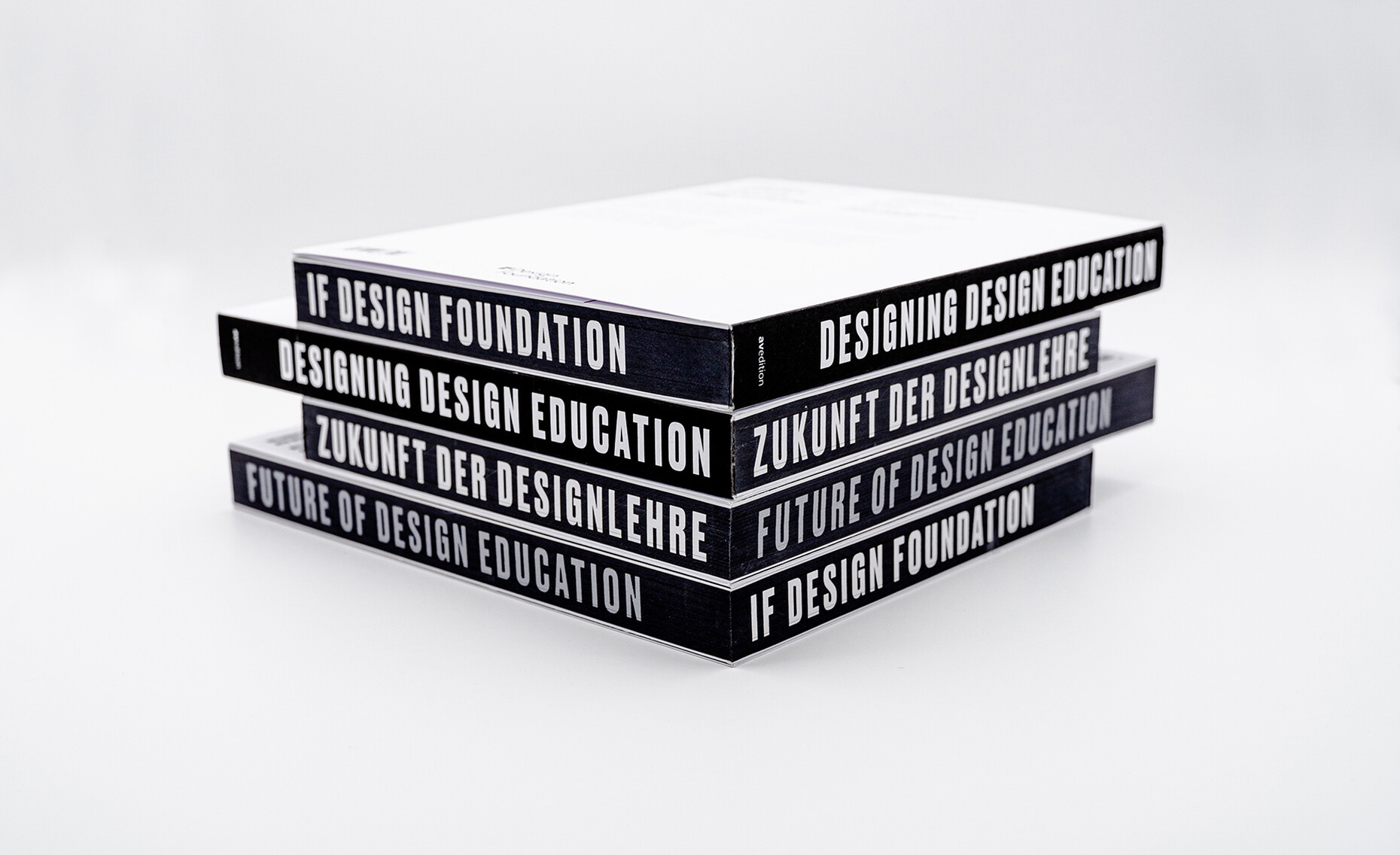Impetus for change
Anna Moldenhauer: René, what prompted you to produce this publication? Was there one triggering moment?
Prof. René Spitz: The trigger was the question from the iF Design Foundation regarding what a university of design should teach if you were to set it up today. It’s actually an enterprising question, since there are already schools of design, of course, so the study really aimed to find out what is already in place, what will be needed in future, and whether there is a difference between the two poles. My proposal was a worldwide, sample-based survey of people who are teaching and learning within the system – with the result being the initial 150 interviews. From these, we compiled the first basic statements.
And what would those be?
Prof. René Spitz: First, what is offered in design education today is no longer what is really needed. Second, there have so far been no initiatives aimed at changing this situation fundamentally, and this exonerates everybody in a way.
The results presented from the study are based on five years of international research. What do they tell us about how design education varies between regions?
Prof. René Spitz: That it varies hugely. It’s a very heterogenous field and relates to the notion of design overall. Different regions interpret it in different ways, hence the teaching varies too. Adult-education institutions link the label of “design” with courses ranging from cosmetics to product design – the span is enormous.
Have you also identified common ground?
Prof. René Spitz: Yes, a lot of activities and skills have given way to digitization over the course of time, or are already a prerequisite for starting the course. The original 20th-century “recipe for success” for design has thus been rendered obsolete. On top of this, it became apparent that in the 21st
century further accumulation of new things generally does not offer any new solutions, but rather creates new problems. In parallel, there is a growing demand for interdisciplinary work, for collaboration on an equal footing beyond the boundaries of languages, cultures, and hierarchies.
Does that mean that nurturing designers’ creative talent is being downgraded?
Prof. René Spitz: No, but the sequence in the process has changed. These days, it’s about stages, about ongoing, never-ending further development. The aesthetic moment will always be important, but it’s no longer first and foremost; now, it comes at the end of a development. Artificial intelligence can undoubtedly not scale all the heights of design, but it already takes care of various stages. The fundamentals of design will remain important, but ever fewer people will be able to earn a living with these alone. Of that I am certain.
After the interview phase you added another, second phase with hearings in multiple regions. What were the criteria by which you selected the questions for participants?
Prof. René Spitz: The questions are based on the findings from the initial 150 interviews. We reformulated them as questions rather than statements, so that participants were able to explore such findings in the second phase of research (the hearings). Basically, we needed 280 pages of explanation about which statements were made and why, but nobody would have read that much material in preparation for the hearings. That’s why we came up with the questions.
And what was the concept behind the selection of participants?
Prof. René Spitz: As with the interviews: The intention behind the selection was to allow for the greatest possible diversity. That meant: students further ahead in their courses, graduates, more senior professionals who had been working in the industry for a while, teaching staff, decision-makers in big companies, small-scale freelancers, well-known and less well-known designers, and people operating at an intermediary level such as PR agencies, journalists and multipliers. The discussions also gave rise to ever more new connections. It is a broad sample for this topic, but not a representative study in a strictly statistical sense – for that, it would need to be much broader.
At least the global research must have given you a profound insight into current design education. On top of that, you are yourself a lecturer in design and communication management at Rheinische Fachhochschule (RFH) in Cologne. In your opinion, how great is the divide really between teaching and practice?
Prof. René Spitz: The divide is great, too great. From industry representatives everywhere, we heard that after completing their degree courses designers have to undergo training in the workplace for a few years initially. On the other hand, students and graduates feel that they are not sufficiently prepared for the reality of the profession. But depending on the way they see themselves, that’s also not something educators are necessarily aiming for; not all universities wish to provide vocational training, but rather to foster the development of personality – practical experience is something students should pursue themselves.
So the design education at many universities currently provides only the theoretical foundation and the job itself has to be learned afterwards like a craft?
Prof. René Spitz: Well, this is the situation described in most academic institutions, at least: They offer a broad framework ranging from historical to social to theoretical points of reference. Specializations are outlined and touched upon, but the relevant consolidation of theory does not allow for immediate vocational practice. That only occurs where connections are established with practical examples in the workplace.
Were there any findings from the interviews that surprised you?
Prof. René Spitz: Yes, usually it’s only towards the end of a study that I see how the results come together and what conclusions can be drawn. In this study, it all happened much more quickly. Even on my first trip to Asia it became clear how unanimous the statements were. With just a few exceptions, I was told by all sources: “We are not doing what we need to do”.
So what should we be doing?
Prof. René Spitz: First of all, it needs to be clear that the way we answer this question in Germany is different to how it would be in Switzerland, Russia, Asia or Africa. One sole way of teaching – an international style of design education, so to speak – is no longer a good idea for the world as a whole. We need to learn from each other, but also to translate the content to our own context. For our environment in Germany, I think the best thing would be to offer project-based teaching from the very first semester, namely with one single practical project for each semester supported by an external organization – which might be a business, an NGO or a public body. The overall teaching should revolve both organizationally and didactically around the realization of this project, from the theory to the actual application. A clear focus that helps to link everything together. This coming together is part of day-to-day work in the profession, and it’s only in educational institutions that we separate the disciplines cleanly from one another.
Are there any aspects of design education that we should be careful not to lose?
Prof. René Spitz: Yes, learning the basics of design. If we limit ourselves to digital tools, then we are going to lose the analogue knowledge, the expertise that is fundamental for the validation of design. This is something we have acquired over centuries, so the knowledge cannot be digitized.
In the foreword to the publication, Dieter Rams calls for a focus on fewer study courses that are nevertheless better equipped. What’s your view on that?
Prof. René Spitz: The unspoken suspicion lurking between the lines here is that there is too much mediocrity in teaching at design universities. Here, we should draw greater distinctions between design excellence as a practice and conveying knowledge as a practice. In my view, a broad spread of teaching at a high level, for example in Germany, is good in many ways. What we’re currently lacking is networking of institutions among one another, so that students can take advantage of different offerings at multiple universities at the same time, for example.
Both Dieter Rams and Ursula von der Leyen also touch on the need for sustainable design in the book. Rams writes that there needs to be more broadly encompassing ethics of design that take into account the reality of people’s lives and the current environmental challenges. To what extent are these calls being heeded in universities?
Prof. René Spitz: If there’s one topic that recurs time and again as an important focus of study courses, then it’s sustainability. And here it applies as a holistic concept, whereby products not only have longevity but can also be repaired, supply chains are reinvented, social security, the circular economy, cultural contexts, etc. are all included. It’s an extremely complex field, but the demand for change is there.
So do you have the impression that the desire among students for sustainable design is not immediately fulfilled when they enter the workplace?
Prof. René Spitz: There is still a difference between the wishes of designers and the possibilities for making these a reality in and with the industry. Nevertheless, I believe students’ desire for change in the system, for a different kind of economy, is indeed genuine.
According to a statement by the iF Design Foundation in the book, our world is “design-driven”, but the significance of design is hard to convey, its diversity and importance in society are underestimated. Why is that?
Prof. René Spitz: In media representation, we are all too often overly superficial, asking too few questions. What’s more, there is a tendency to focus on the whimsical side of design, which may well be entertaining but produces a misleading picture with regard to the economic reality or the professional profile of designers in general.
Why do you think there is this focus on the supposedly glamorous world of design?
Prof. René Spitz: There is a tendency among the media in that direction, but also a reaction to it among people in design. Those who serve the stereotype gain attention.
So does the system serve both sides?
Prof. René Spitz: Yes, definitely. I find that even people who are regularly involved in design can be very blinkered. When I wanted to write a column on design in the digital realm, such as the “like” button on Facebook or the “at” sign as an element of e-mail, I was asked what that had to do with design; they said that was programming. The huge range of activities design involves is largely unacknowledged.
Your book is a temporary, comprehensive view of the status quo of design education. What does the iF Design Foundation aim to foster with its publication?
Prof. René Spitz: The book is a way of prompting discussion of the question: What does the current situation in universities mean for us in Germany? It doesn’t offer any kind of checklist for the perfect design university in our time, but rather forms a basis for discussion. Right now, various international universities are seeking dialogue with us in order to discuss the findings. That means we have achieved our objective already. There is definitely a desire among universities to reflect on and question the current teaching of design. The white paper may provide the impetus that was missing for them to start taking action. For us, it would be ideal if, as a result of this study, an educational institution were to say: “We’re going to do everything differently now”, then rolled up its sleeves and went about practical reorganization.
Designing Design Education: Weißbuch zur Zukunft der Designlehre / Whitebook on the Future of Design Education
Editors: Christoph Böninger, Fritz Frenkler, Susanne Schmidhuber
Text: René Spitz
Essays: Lani Adeoye, Ekkehart Baumgartner, Annette Diefenthaler, Sushi Suzuki
312 pages, 438 illustrations
German / English
ISBN: 978-3-89986-341-3
49 Euro








